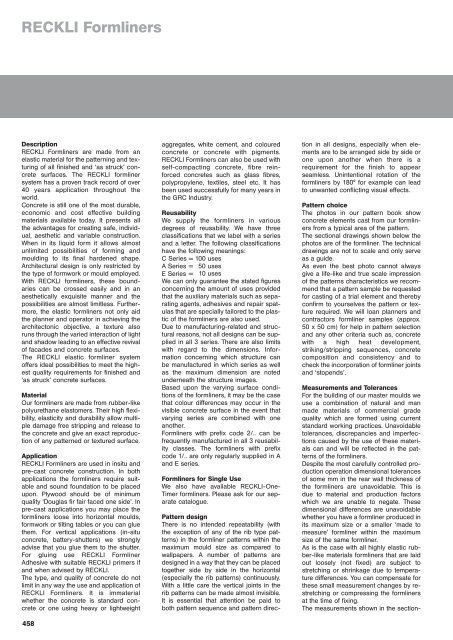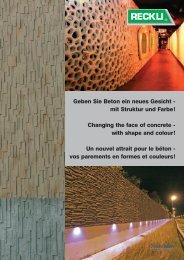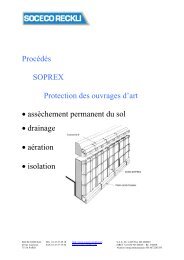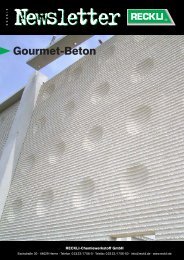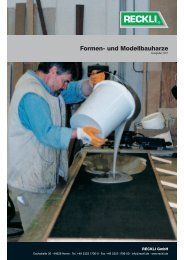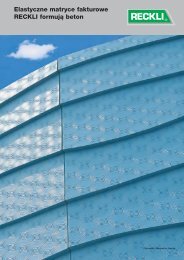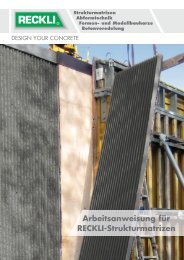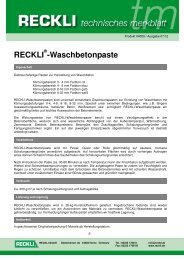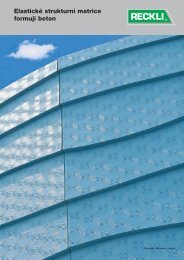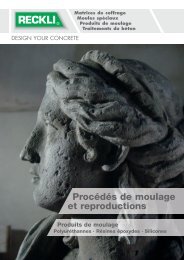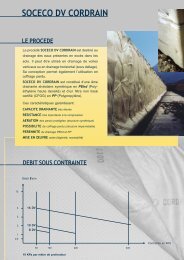2/24 Donau - RECKLI GmbH: Home
2/24 Donau - RECKLI GmbH: Home
2/24 Donau - RECKLI GmbH: Home
You also want an ePaper? Increase the reach of your titles
YUMPU automatically turns print PDFs into web optimized ePapers that Google loves.
<strong>RECKLI</strong> FormlinersDescription<strong>RECKLI</strong> Formliners are made from anelastic material for the patterning and texturingof all finished and ‘as struck’ concretesurfaces. The <strong>RECKLI</strong> formlinersystem has a proven track record of over40 years application throughout theworld.Concrete is still one of the most durable,economic and cost effective buildingmaterials available today. It presents allthe advantages for creating safe, individual,aesthetic and variable construction.When in its liquid form it allows almostunlimited possibilities of forming andmoulding to its final hardened shape.Architectural design is only restricted bythe type of formwork or mould employed.With <strong>RECKLI</strong> formliners, these boundariescan be crossed easily and in anaesthetically exquisite manner and thepossibilities are almost limitless. Further -more, the elastic formliners not only aidthe planner and operator in achieving thearchitectonic objective, a texture alsoruns through the varied interaction of lightand shadow leading to an effective revivalof facades and concrete surfaces.The <strong>RECKLI</strong> elastic formliner systemoffers ideal possibilities to meet the highestquality requirements for finished and‘as struck’ concrete surfaces.MaterialOur formliners are made from rubber-likepolyurethane elastomers. Their high flexibility,elasticity and durability allow multipledamage free stripping and release tothe concrete and give an exact reproductionof any patterned or textured surface.Application<strong>RECKLI</strong> Formliners are used in insitu andpre-cast concrete construction. In bothapplications the formliners require suitableand sound foundation to be placedupon. Plywood should be of minimumquality ‘Douglas fir fair faced one side’. Inpre-cast applications you may place theformliners loose into horizontal moulds,formwork or tilting tables or you can gluethem. For vertical applications (in-situconcrete, battery-shutters) we stronglyadvise that you glue them to the shutter.For gluing use <strong>RECKLI</strong> FormlinerAdhesive with suitable <strong>RECKLI</strong> primers ifand when advised by <strong>RECKLI</strong>.The type, and quality of concrete do notlimit in any way the use and application of<strong>RECKLI</strong> Formliners. It is immaterialwhether the concrete is standard concreteor one using heavy or lightweight458aggregates, white cement, and colouredconcrete or concrete with pigments.<strong>RECKLI</strong> Formliners can also be used withself-compacting concrete, fibre reinforcedconcretes such as glass fibres,polypropylene, textiles, steel etc. It hasbeen used successfully for many years inthe GRC Industry.ReusabilityWe supply the formliners in variousdegrees of reusability. We have threeclassifications that we label with a seriesand a letter. The following classificationshave the following meanings:C Series = 100 usesA Series = 150 usesE Series = 110 usesWe can only guarantee the stated figuresconcerning the amount of uses providedthat the auxiliary materials such as separatingagents, adhesives and repair spatulasthat are specially tailored to the plasticof the formliners are also used.Due to manufacturing-related and structuralreasons, not all designs can be suppliedin all 3 series. There are also limitswith regard to the dimensions. Infor -mation concerning which structure canbe manufactured in which series as wellas the maximum dimension are notedunderneath the structure images.Based upon the varying surface conditionsof the formliners, it may be the casethat colour differences may occur in thevisible concrete surface in the event thatvarying series are combined with oneanother.Formliners with prefix code 2/.. can befrequently manufactured in all 3 reusabilityclasses. The formliners with prefixcode 1/.. are only regularly supplied in Aand E series.Formliners for Single UseWe also have available <strong>RECKLI</strong>-One-Timer formliners. Please ask for our separatecatalogue.Pattern designThere is no intended repeatability (withthe exception of any of the rib type patterns)in the formliner patterns within themaximum mould size as compared towallpapers. A number of patterns aredesigned in a way that they can be placedtogether side by side in the horizontal(especially the rib patterns) continuously.With a little care the vertical joints in therib patterns can be made almost invisible.It is essential that attention be paid toboth pattern sequence and pattern directionin all designs, especially when elementsare to be arranged side by side orone upon another when there is arequirement for the finish to appearseamless. Unintentional rotation of theformliners by 180° for example can leadto unwanted conflicting visual effects.Pattern choiceThe photos in our pattern book showconcrete elements cast from our formlinersfrom a typical area of the pattern.The sectional drawings shown below thephotos are of the formliner. The technicaldrawings are not to scale and only serveas a guide.As even the best photo cannot alwaysgive a life-like and true scale impressionof the patterns characteristics we recommendthat a pattern sample be requestedfor casting of a trial element and therebyconfirm to yourselves the pattern or texturerequired. We will loan planners andcontractors formliner samples (approx.50 x 50 cm) for help in pattern selectionand any other criteria such as, concretewith a high heat development,striking/stripping sequences, concretecomposition and consistency and tocheck the incorporation of formliner jointsand ‘stopends’.Measurements and TolerancesFor the building of our master moulds weuse a combination of natural and manmade materials of commercial gradequality which are formed using currentstandard working practices. Unavoidabletolerances, discrepancies and imperfectionscaused by the use of these materialscan and will be reflected in the patternsof the formliners.Despite the most carefully controlled productionoperation dimensional tolerancesof some mm in the rear wall thickness ofthe formliners are unavoidable. This isdue to material and production factorswhich we are unable to negate. Thesedimensional differences are unavoidablewhether you have a formliner produced inits maximum size or a smaller ‘made tomeasure’ formliner within the maximumsize of the same formliner.As is the case with all highly elastic rubber-likematerials formliners that are laidout loosely (not fixed) are subject tostretching or shrinkage due to temperaturedifferences. You can compensate forthese small measurement changes by restretchingor compressing the formlinersat the time of fixing.The measurements shown in the section-


